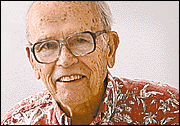


Hawaii’s World
NOBODY I know of has written "I left my heart in Hilo" (as with San Francisco) or "Hilo! Hilo!" (as with New York) but a musical ode to the city seems in order. An ode to
Big Isle’s port cityHilo is Hawaii's most beautiful small city. Bayfront small boats at Reed's Bay.Banyan Drive shaded with trees planted by yesterday's celebrities. A beautiful Shinto-style Japanese garden at Liliuokalani Park. Lunch picnicking by the ponds of Wailoa State Park. Nearly a mile of Hilo Bay waterfront now wisely left as a park after tsunamis in 1946 and 1960 wiped out its buildings.
Hilo is the closest you will come to visiting a sugar-era Hawaii town. Small shops and residences cluttered together. Streets mostly uncrowded.
On a clear day 13,000-foot Mauna Kea looms behind the city, sometimes with a topping of snow, always now with the topping of the telescopes that have made it the world's No. 1 astronomy base.
Hilo is Hawaii's rainiest city but clear days pop up more than half the time. It was the port for shipping raw sugar from around one dozen Big Island plantations, all now defunct. At least one cruise ship stops a week. More will be coming.
Hilo has new vitality from fast-growing University of Hawaii-Hilo with marine, agricultural and Hawaiian language specialities. C. Brewer, Hawaii's oldest Big Five firm, has moved its headquarters there from Honolulu to promote diversified ag to replace sugar. At Wednesday and Saturday markets on Kamehameha Avenue you can glimpse the potential and also get eight papayas for a dollar. Maybe some crops will fit into a song rhythm along with humuhumunukunukus swimming in Kealakekua Bay.
Hilo has old vitality as the county seat and site of the Big Island's major federal and state office buildings. It is blessed with a lazy, oversized airport terminal built before jets could deliver tourists direct to Kona on the sunny side of the island.
Bed and breakfasts are giving Hilo's hotels competition. My wife and I recently stayed at Shipman House, a century-old white Victorian mansion that is on the National Historic Register. Jack London was a guest in 1907. Queen Liliuokalani once dined there after she was deposed. Herbert Shipman, who built it, is remembered for saving the Big Island's wingless goose, the nene, by shipping a few survivors to London to breed more nene to be released in the lava areas they long ago adapted to so well they gave up flying.
THERE is a contest of sorts between Hilo and Kamuela to provide the base sites for astronomy on Mauna Kea. The giant Keck which just spotted the first planet in another universe is based at Kamuela. But Hilo seems to be pulling ahead thanks to the University of Hawaii's decision to build its astronomy headquarters at Hilo's University Park, just mauka of but separate from the campus of the UH-Hilo. Hilo has a closer freight port, a closer airport and the UH-Hilo backup.
Expansion of the mountain-top telescopes now is being debated with challenges from environmentalists and some native Hawaiians. Chile looms as an alternate site if we nix further growth. Chile has unlimited potential atop a mountain range but a poorer latitude location.
Challenges are a manifestation of the Big Island's population diversity. They stopped a space port at South Point, seem to have discouraged a new state prison and barely allowed radiation to assure bug-free papayas to be sent to overseas markets. Maybe that, too, can fit into a song lyric.
A.A. Smyser is the contributing editor
and former editor of the the Star-Bulletin
His column runs Tuesday and Thursday.